Salaries and Wage Budget for Health Care Facilities
VerifiedAdded on 2021/04/16
|11
|3234
|71
AI Summary
The assignment provided is about preparing salaries and wage budgets for health care facilities. It includes the mandatory remuneration components that should be received by personnel in the health care sector. The document assumes the different salary components given by reputable health care institutions in Australia, including overtime allowance due to expanded work space. This process requires skilled analysis and evaluation from planning the facility to budget preparation.
Contribute Materials
Your contribution can guide someone’s learning journey. Share your
documents today.
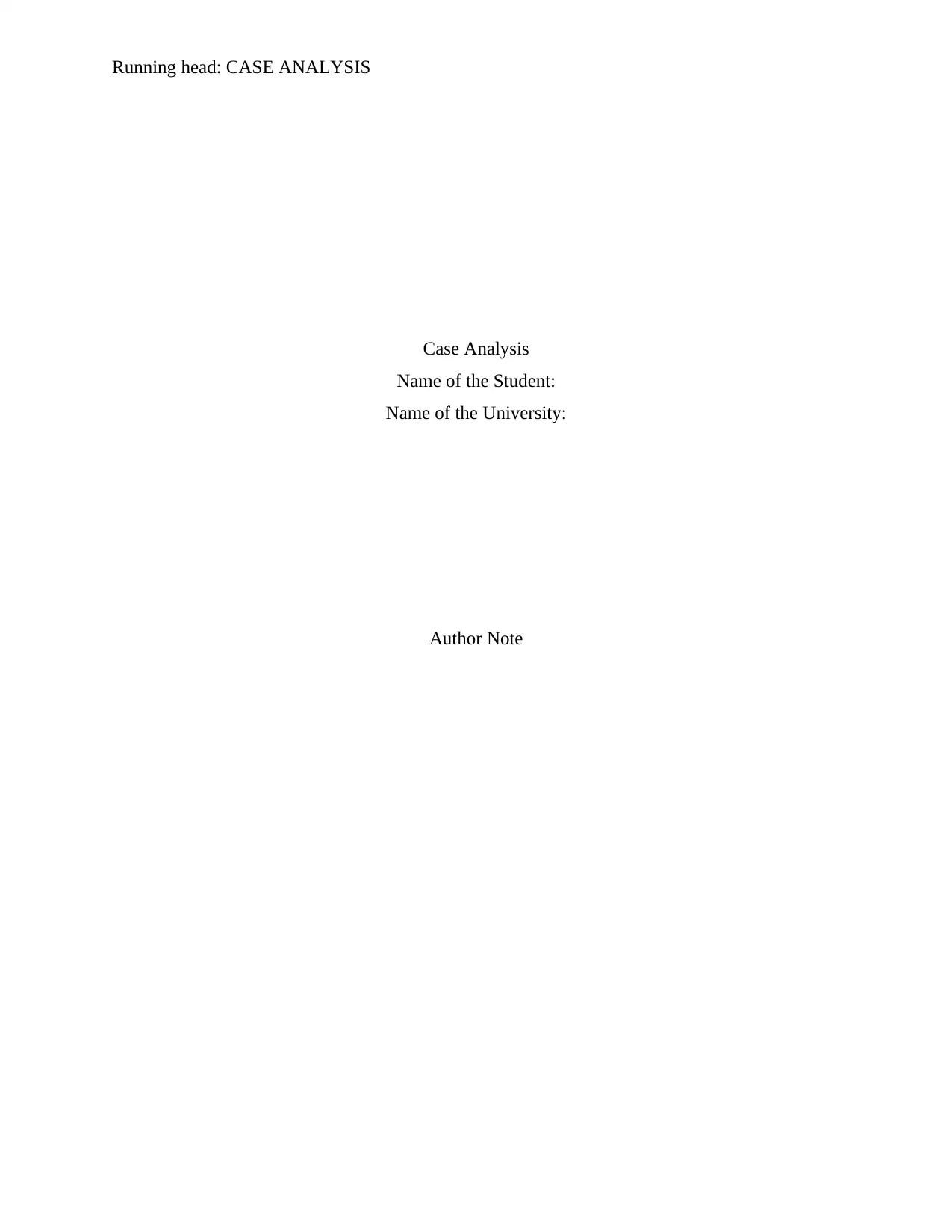
Running head: CASE ANALYSIS
Case Analysis
Name of the Student:
Name of the University:
Author Note
Case Analysis
Name of the Student:
Name of the University:
Author Note
Secure Best Marks with AI Grader
Need help grading? Try our AI Grader for instant feedback on your assignments.
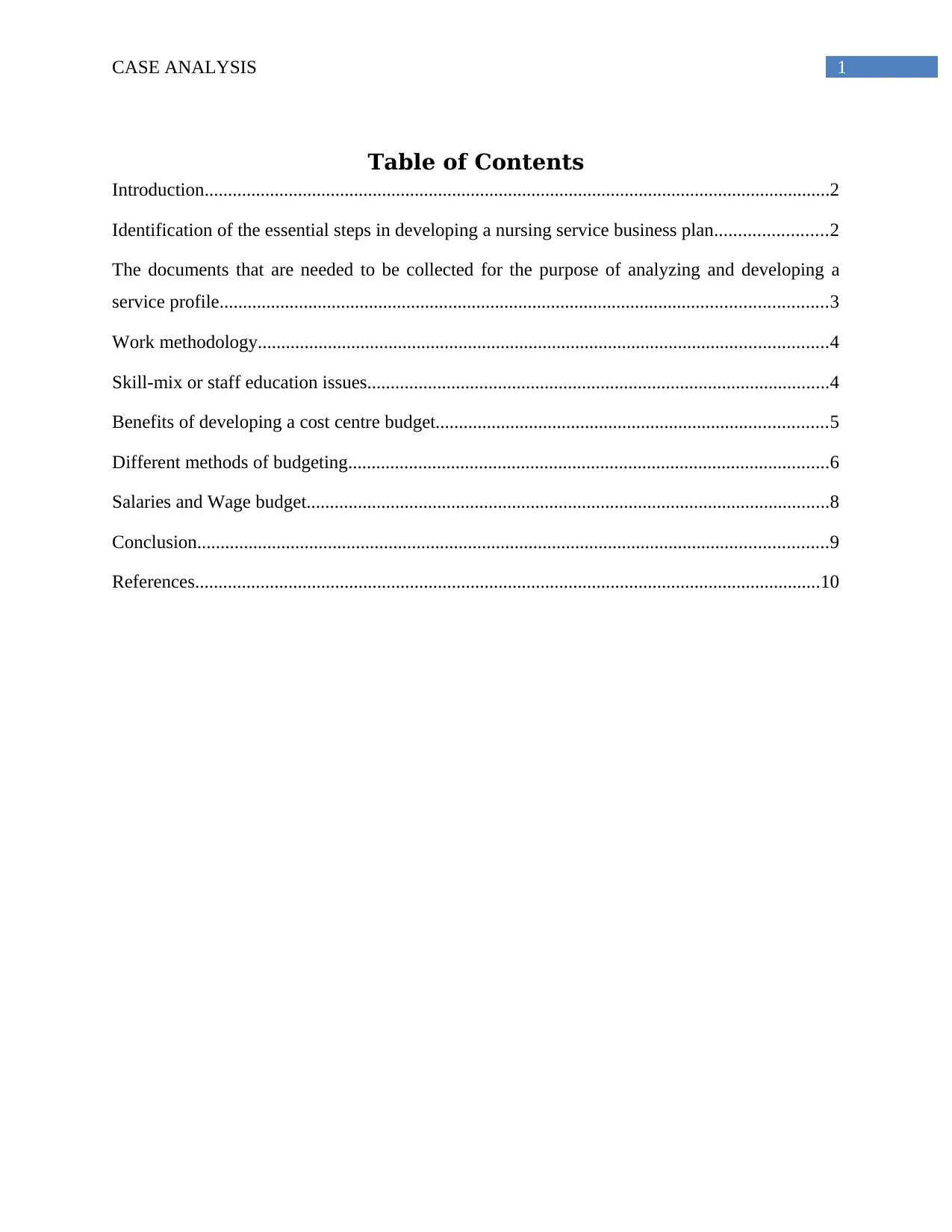
1CASE ANALYSIS
Table of Contents
Introduction......................................................................................................................................2
Identification of the essential steps in developing a nursing service business plan........................2
The documents that are needed to be collected for the purpose of analyzing and developing a
service profile..................................................................................................................................3
Work methodology..........................................................................................................................4
Skill-mix or staff education issues...................................................................................................4
Benefits of developing a cost centre budget....................................................................................5
Different methods of budgeting.......................................................................................................6
Salaries and Wage budget................................................................................................................8
Conclusion.......................................................................................................................................9
References......................................................................................................................................10
Table of Contents
Introduction......................................................................................................................................2
Identification of the essential steps in developing a nursing service business plan........................2
The documents that are needed to be collected for the purpose of analyzing and developing a
service profile..................................................................................................................................3
Work methodology..........................................................................................................................4
Skill-mix or staff education issues...................................................................................................4
Benefits of developing a cost centre budget....................................................................................5
Different methods of budgeting.......................................................................................................6
Salaries and Wage budget................................................................................................................8
Conclusion.......................................................................................................................................9
References......................................................................................................................................10
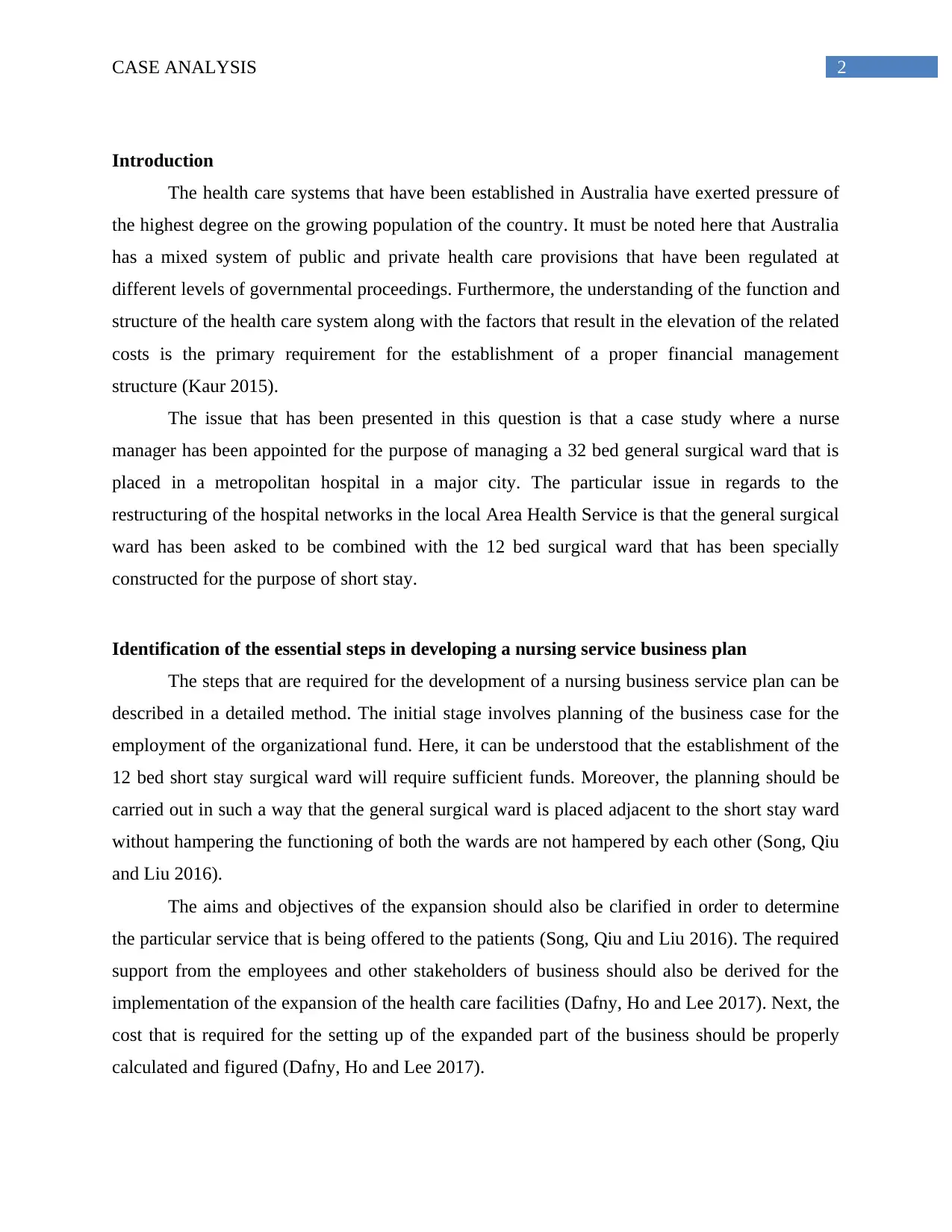
2CASE ANALYSIS
Introduction
The health care systems that have been established in Australia have exerted pressure of
the highest degree on the growing population of the country. It must be noted here that Australia
has a mixed system of public and private health care provisions that have been regulated at
different levels of governmental proceedings. Furthermore, the understanding of the function and
structure of the health care system along with the factors that result in the elevation of the related
costs is the primary requirement for the establishment of a proper financial management
structure (Kaur 2015).
The issue that has been presented in this question is that a case study where a nurse
manager has been appointed for the purpose of managing a 32 bed general surgical ward that is
placed in a metropolitan hospital in a major city. The particular issue in regards to the
restructuring of the hospital networks in the local Area Health Service is that the general surgical
ward has been asked to be combined with the 12 bed surgical ward that has been specially
constructed for the purpose of short stay.
Identification of the essential steps in developing a nursing service business plan
The steps that are required for the development of a nursing business service plan can be
described in a detailed method. The initial stage involves planning of the business case for the
employment of the organizational fund. Here, it can be understood that the establishment of the
12 bed short stay surgical ward will require sufficient funds. Moreover, the planning should be
carried out in such a way that the general surgical ward is placed adjacent to the short stay ward
without hampering the functioning of both the wards are not hampered by each other (Song, Qiu
and Liu 2016).
The aims and objectives of the expansion should also be clarified in order to determine
the particular service that is being offered to the patients (Song, Qiu and Liu 2016). The required
support from the employees and other stakeholders of business should also be derived for the
implementation of the expansion of the health care facilities (Dafny, Ho and Lee 2017). Next, the
cost that is required for the setting up of the expanded part of the business should be properly
calculated and figured (Dafny, Ho and Lee 2017).
Introduction
The health care systems that have been established in Australia have exerted pressure of
the highest degree on the growing population of the country. It must be noted here that Australia
has a mixed system of public and private health care provisions that have been regulated at
different levels of governmental proceedings. Furthermore, the understanding of the function and
structure of the health care system along with the factors that result in the elevation of the related
costs is the primary requirement for the establishment of a proper financial management
structure (Kaur 2015).
The issue that has been presented in this question is that a case study where a nurse
manager has been appointed for the purpose of managing a 32 bed general surgical ward that is
placed in a metropolitan hospital in a major city. The particular issue in regards to the
restructuring of the hospital networks in the local Area Health Service is that the general surgical
ward has been asked to be combined with the 12 bed surgical ward that has been specially
constructed for the purpose of short stay.
Identification of the essential steps in developing a nursing service business plan
The steps that are required for the development of a nursing business service plan can be
described in a detailed method. The initial stage involves planning of the business case for the
employment of the organizational fund. Here, it can be understood that the establishment of the
12 bed short stay surgical ward will require sufficient funds. Moreover, the planning should be
carried out in such a way that the general surgical ward is placed adjacent to the short stay ward
without hampering the functioning of both the wards are not hampered by each other (Song, Qiu
and Liu 2016).
The aims and objectives of the expansion should also be clarified in order to determine
the particular service that is being offered to the patients (Song, Qiu and Liu 2016). The required
support from the employees and other stakeholders of business should also be derived for the
implementation of the expansion of the health care facilities (Dafny, Ho and Lee 2017). Next, the
cost that is required for the setting up of the expanded part of the business should be properly
calculated and figured (Dafny, Ho and Lee 2017).
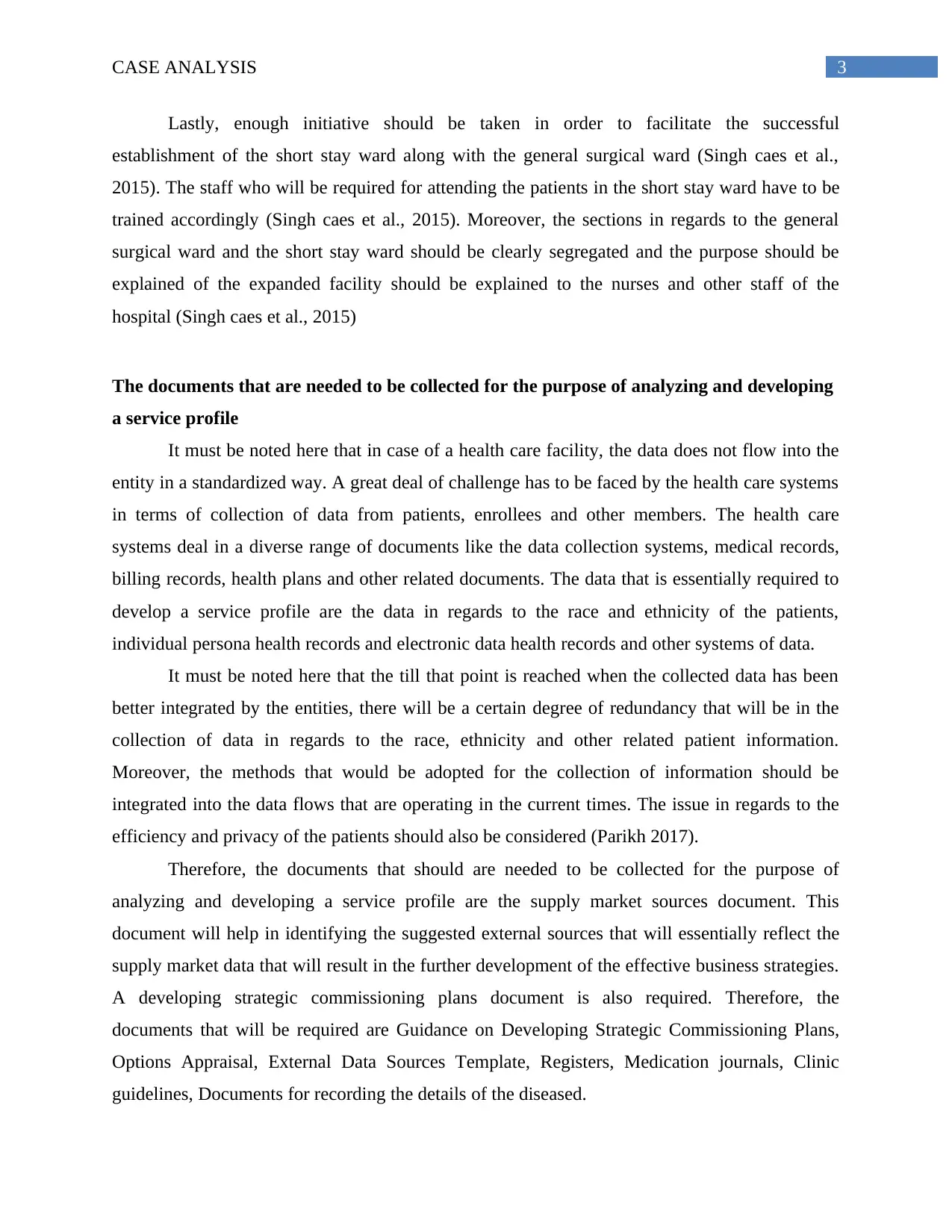
3CASE ANALYSIS
Lastly, enough initiative should be taken in order to facilitate the successful
establishment of the short stay ward along with the general surgical ward (Singh caes et al.,
2015). The staff who will be required for attending the patients in the short stay ward have to be
trained accordingly (Singh caes et al., 2015). Moreover, the sections in regards to the general
surgical ward and the short stay ward should be clearly segregated and the purpose should be
explained of the expanded facility should be explained to the nurses and other staff of the
hospital (Singh caes et al., 2015)
The documents that are needed to be collected for the purpose of analyzing and developing
a service profile
It must be noted here that in case of a health care facility, the data does not flow into the
entity in a standardized way. A great deal of challenge has to be faced by the health care systems
in terms of collection of data from patients, enrollees and other members. The health care
systems deal in a diverse range of documents like the data collection systems, medical records,
billing records, health plans and other related documents. The data that is essentially required to
develop a service profile are the data in regards to the race and ethnicity of the patients,
individual persona health records and electronic data health records and other systems of data.
It must be noted here that the till that point is reached when the collected data has been
better integrated by the entities, there will be a certain degree of redundancy that will be in the
collection of data in regards to the race, ethnicity and other related patient information.
Moreover, the methods that would be adopted for the collection of information should be
integrated into the data flows that are operating in the current times. The issue in regards to the
efficiency and privacy of the patients should also be considered (Parikh 2017).
Therefore, the documents that should are needed to be collected for the purpose of
analyzing and developing a service profile are the supply market sources document. This
document will help in identifying the suggested external sources that will essentially reflect the
supply market data that will result in the further development of the effective business strategies.
A developing strategic commissioning plans document is also required. Therefore, the
documents that will be required are Guidance on Developing Strategic Commissioning Plans,
Options Appraisal, External Data Sources Template, Registers, Medication journals, Clinic
guidelines, Documents for recording the details of the diseased.
Lastly, enough initiative should be taken in order to facilitate the successful
establishment of the short stay ward along with the general surgical ward (Singh caes et al.,
2015). The staff who will be required for attending the patients in the short stay ward have to be
trained accordingly (Singh caes et al., 2015). Moreover, the sections in regards to the general
surgical ward and the short stay ward should be clearly segregated and the purpose should be
explained of the expanded facility should be explained to the nurses and other staff of the
hospital (Singh caes et al., 2015)
The documents that are needed to be collected for the purpose of analyzing and developing
a service profile
It must be noted here that in case of a health care facility, the data does not flow into the
entity in a standardized way. A great deal of challenge has to be faced by the health care systems
in terms of collection of data from patients, enrollees and other members. The health care
systems deal in a diverse range of documents like the data collection systems, medical records,
billing records, health plans and other related documents. The data that is essentially required to
develop a service profile are the data in regards to the race and ethnicity of the patients,
individual persona health records and electronic data health records and other systems of data.
It must be noted here that the till that point is reached when the collected data has been
better integrated by the entities, there will be a certain degree of redundancy that will be in the
collection of data in regards to the race, ethnicity and other related patient information.
Moreover, the methods that would be adopted for the collection of information should be
integrated into the data flows that are operating in the current times. The issue in regards to the
efficiency and privacy of the patients should also be considered (Parikh 2017).
Therefore, the documents that should are needed to be collected for the purpose of
analyzing and developing a service profile are the supply market sources document. This
document will help in identifying the suggested external sources that will essentially reflect the
supply market data that will result in the further development of the effective business strategies.
A developing strategic commissioning plans document is also required. Therefore, the
documents that will be required are Guidance on Developing Strategic Commissioning Plans,
Options Appraisal, External Data Sources Template, Registers, Medication journals, Clinic
guidelines, Documents for recording the details of the diseased.
Secure Best Marks with AI Grader
Need help grading? Try our AI Grader for instant feedback on your assignments.
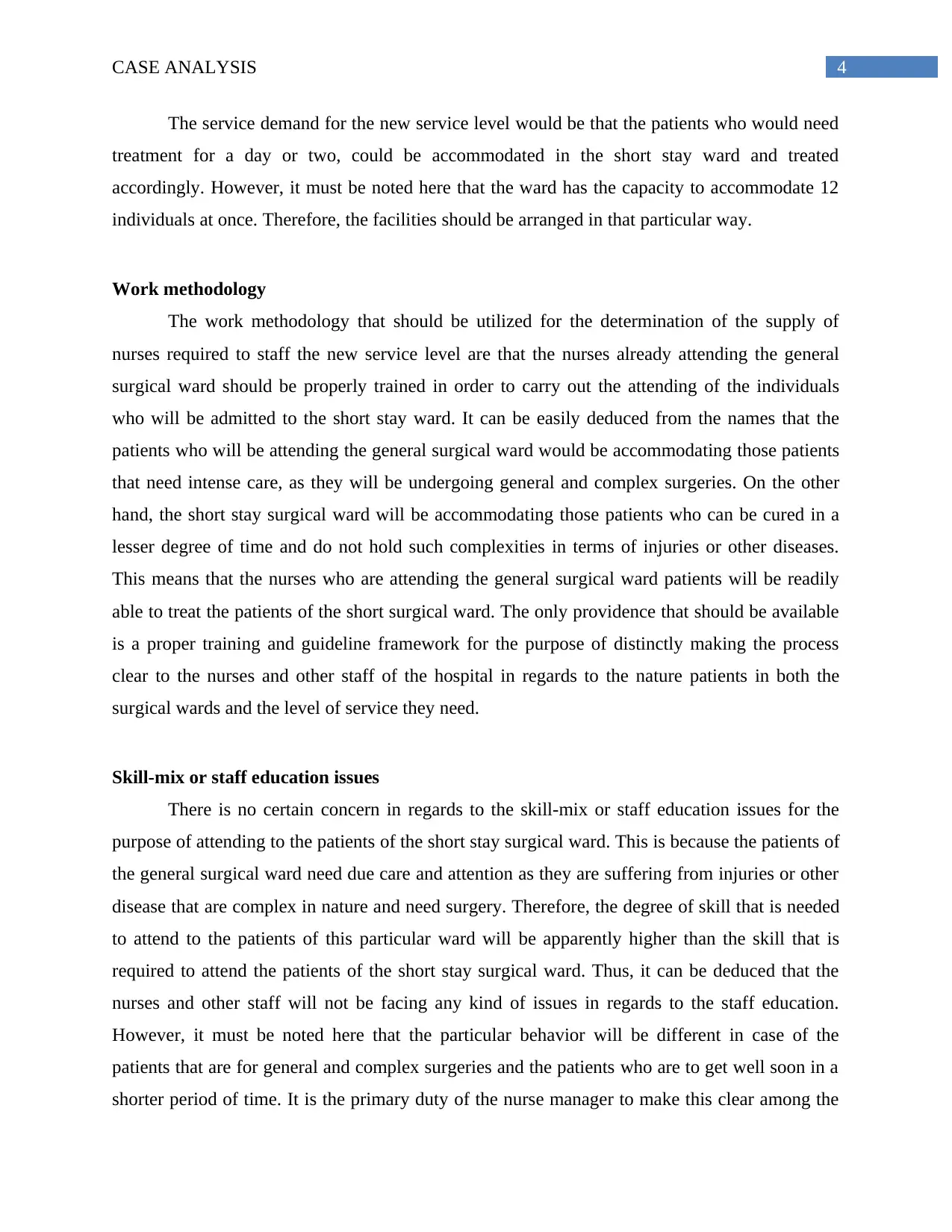
4CASE ANALYSIS
The service demand for the new service level would be that the patients who would need
treatment for a day or two, could be accommodated in the short stay ward and treated
accordingly. However, it must be noted here that the ward has the capacity to accommodate 12
individuals at once. Therefore, the facilities should be arranged in that particular way.
Work methodology
The work methodology that should be utilized for the determination of the supply of
nurses required to staff the new service level are that the nurses already attending the general
surgical ward should be properly trained in order to carry out the attending of the individuals
who will be admitted to the short stay ward. It can be easily deduced from the names that the
patients who will be attending the general surgical ward would be accommodating those patients
that need intense care, as they will be undergoing general and complex surgeries. On the other
hand, the short stay surgical ward will be accommodating those patients who can be cured in a
lesser degree of time and do not hold such complexities in terms of injuries or other diseases.
This means that the nurses who are attending the general surgical ward patients will be readily
able to treat the patients of the short surgical ward. The only providence that should be available
is a proper training and guideline framework for the purpose of distinctly making the process
clear to the nurses and other staff of the hospital in regards to the nature patients in both the
surgical wards and the level of service they need.
Skill-mix or staff education issues
There is no certain concern in regards to the skill-mix or staff education issues for the
purpose of attending to the patients of the short stay surgical ward. This is because the patients of
the general surgical ward need due care and attention as they are suffering from injuries or other
disease that are complex in nature and need surgery. Therefore, the degree of skill that is needed
to attend to the patients of this particular ward will be apparently higher than the skill that is
required to attend the patients of the short stay surgical ward. Thus, it can be deduced that the
nurses and other staff will not be facing any kind of issues in regards to the staff education.
However, it must be noted here that the particular behavior will be different in case of the
patients that are for general and complex surgeries and the patients who are to get well soon in a
shorter period of time. It is the primary duty of the nurse manager to make this clear among the
The service demand for the new service level would be that the patients who would need
treatment for a day or two, could be accommodated in the short stay ward and treated
accordingly. However, it must be noted here that the ward has the capacity to accommodate 12
individuals at once. Therefore, the facilities should be arranged in that particular way.
Work methodology
The work methodology that should be utilized for the determination of the supply of
nurses required to staff the new service level are that the nurses already attending the general
surgical ward should be properly trained in order to carry out the attending of the individuals
who will be admitted to the short stay ward. It can be easily deduced from the names that the
patients who will be attending the general surgical ward would be accommodating those patients
that need intense care, as they will be undergoing general and complex surgeries. On the other
hand, the short stay surgical ward will be accommodating those patients who can be cured in a
lesser degree of time and do not hold such complexities in terms of injuries or other diseases.
This means that the nurses who are attending the general surgical ward patients will be readily
able to treat the patients of the short surgical ward. The only providence that should be available
is a proper training and guideline framework for the purpose of distinctly making the process
clear to the nurses and other staff of the hospital in regards to the nature patients in both the
surgical wards and the level of service they need.
Skill-mix or staff education issues
There is no certain concern in regards to the skill-mix or staff education issues for the
purpose of attending to the patients of the short stay surgical ward. This is because the patients of
the general surgical ward need due care and attention as they are suffering from injuries or other
disease that are complex in nature and need surgery. Therefore, the degree of skill that is needed
to attend to the patients of this particular ward will be apparently higher than the skill that is
required to attend the patients of the short stay surgical ward. Thus, it can be deduced that the
nurses and other staff will not be facing any kind of issues in regards to the staff education.
However, it must be noted here that the particular behavior will be different in case of the
patients that are for general and complex surgeries and the patients who are to get well soon in a
shorter period of time. It is the primary duty of the nurse manager to make this clear among the
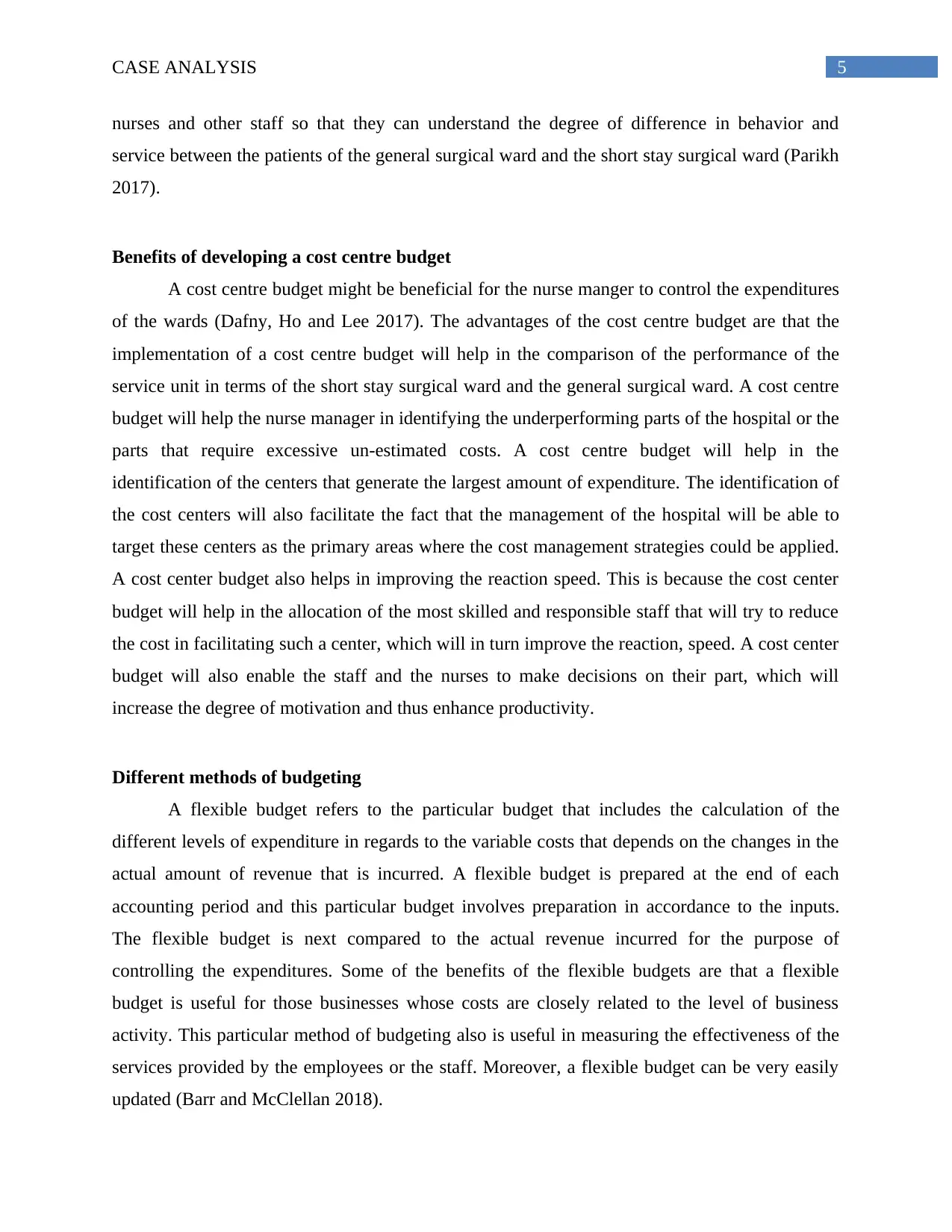
5CASE ANALYSIS
nurses and other staff so that they can understand the degree of difference in behavior and
service between the patients of the general surgical ward and the short stay surgical ward (Parikh
2017).
Benefits of developing a cost centre budget
A cost centre budget might be beneficial for the nurse manger to control the expenditures
of the wards (Dafny, Ho and Lee 2017). The advantages of the cost centre budget are that the
implementation of a cost centre budget will help in the comparison of the performance of the
service unit in terms of the short stay surgical ward and the general surgical ward. A cost centre
budget will help the nurse manager in identifying the underperforming parts of the hospital or the
parts that require excessive un-estimated costs. A cost centre budget will help in the
identification of the centers that generate the largest amount of expenditure. The identification of
the cost centers will also facilitate the fact that the management of the hospital will be able to
target these centers as the primary areas where the cost management strategies could be applied.
A cost center budget also helps in improving the reaction speed. This is because the cost center
budget will help in the allocation of the most skilled and responsible staff that will try to reduce
the cost in facilitating such a center, which will in turn improve the reaction, speed. A cost center
budget will also enable the staff and the nurses to make decisions on their part, which will
increase the degree of motivation and thus enhance productivity.
Different methods of budgeting
A flexible budget refers to the particular budget that includes the calculation of the
different levels of expenditure in regards to the variable costs that depends on the changes in the
actual amount of revenue that is incurred. A flexible budget is prepared at the end of each
accounting period and this particular budget involves preparation in accordance to the inputs.
The flexible budget is next compared to the actual revenue incurred for the purpose of
controlling the expenditures. Some of the benefits of the flexible budgets are that a flexible
budget is useful for those businesses whose costs are closely related to the level of business
activity. This particular method of budgeting also is useful in measuring the effectiveness of the
services provided by the employees or the staff. Moreover, a flexible budget can be very easily
updated (Barr and McClellan 2018).
nurses and other staff so that they can understand the degree of difference in behavior and
service between the patients of the general surgical ward and the short stay surgical ward (Parikh
2017).
Benefits of developing a cost centre budget
A cost centre budget might be beneficial for the nurse manger to control the expenditures
of the wards (Dafny, Ho and Lee 2017). The advantages of the cost centre budget are that the
implementation of a cost centre budget will help in the comparison of the performance of the
service unit in terms of the short stay surgical ward and the general surgical ward. A cost centre
budget will help the nurse manager in identifying the underperforming parts of the hospital or the
parts that require excessive un-estimated costs. A cost centre budget will help in the
identification of the centers that generate the largest amount of expenditure. The identification of
the cost centers will also facilitate the fact that the management of the hospital will be able to
target these centers as the primary areas where the cost management strategies could be applied.
A cost center budget also helps in improving the reaction speed. This is because the cost center
budget will help in the allocation of the most skilled and responsible staff that will try to reduce
the cost in facilitating such a center, which will in turn improve the reaction, speed. A cost center
budget will also enable the staff and the nurses to make decisions on their part, which will
increase the degree of motivation and thus enhance productivity.
Different methods of budgeting
A flexible budget refers to the particular budget that includes the calculation of the
different levels of expenditure in regards to the variable costs that depends on the changes in the
actual amount of revenue that is incurred. A flexible budget is prepared at the end of each
accounting period and this particular budget involves preparation in accordance to the inputs.
The flexible budget is next compared to the actual revenue incurred for the purpose of
controlling the expenditures. Some of the benefits of the flexible budgets are that a flexible
budget is useful for those businesses whose costs are closely related to the level of business
activity. This particular method of budgeting also is useful in measuring the effectiveness of the
services provided by the employees or the staff. Moreover, a flexible budget can be very easily
updated (Barr and McClellan 2018).
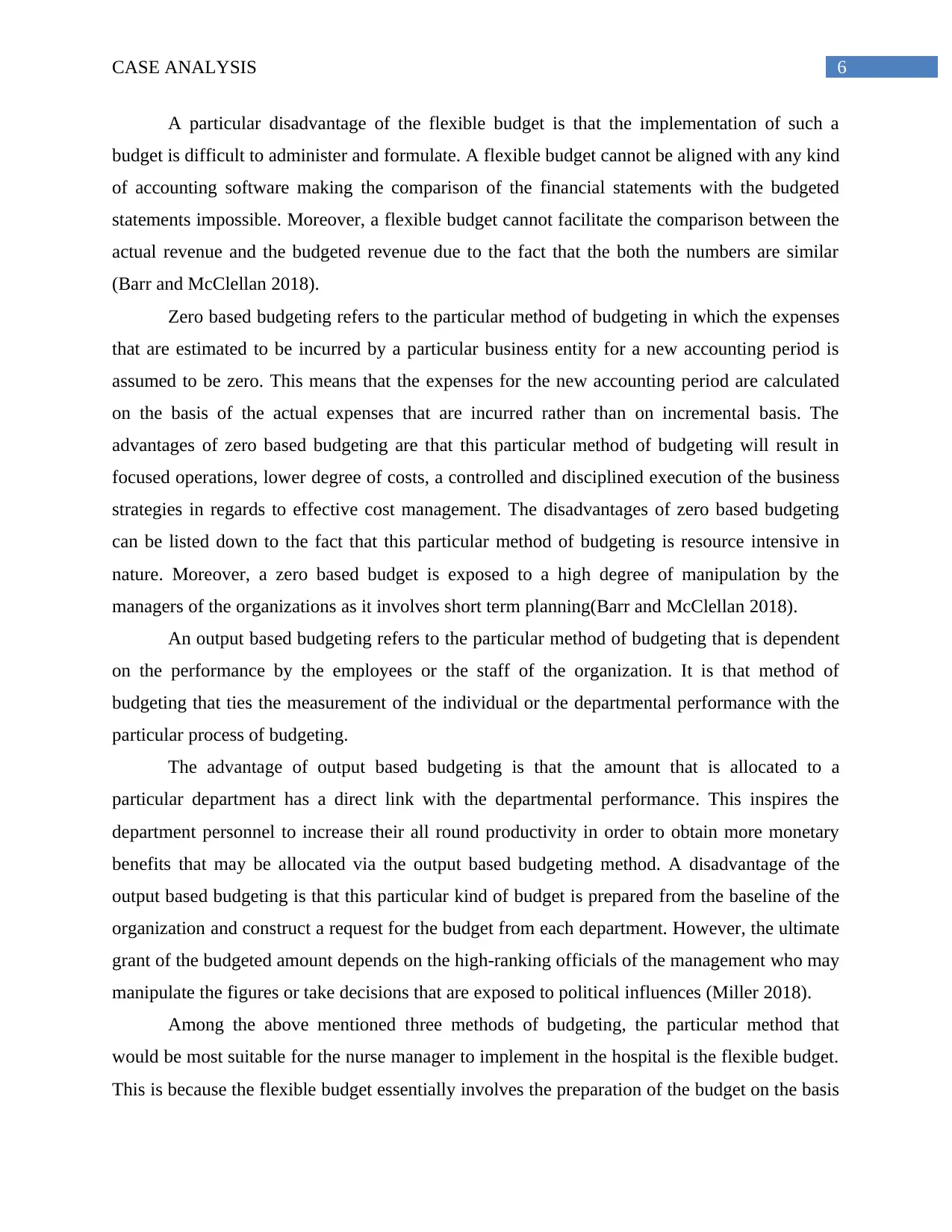
6CASE ANALYSIS
A particular disadvantage of the flexible budget is that the implementation of such a
budget is difficult to administer and formulate. A flexible budget cannot be aligned with any kind
of accounting software making the comparison of the financial statements with the budgeted
statements impossible. Moreover, a flexible budget cannot facilitate the comparison between the
actual revenue and the budgeted revenue due to the fact that the both the numbers are similar
(Barr and McClellan 2018).
Zero based budgeting refers to the particular method of budgeting in which the expenses
that are estimated to be incurred by a particular business entity for a new accounting period is
assumed to be zero. This means that the expenses for the new accounting period are calculated
on the basis of the actual expenses that are incurred rather than on incremental basis. The
advantages of zero based budgeting are that this particular method of budgeting will result in
focused operations, lower degree of costs, a controlled and disciplined execution of the business
strategies in regards to effective cost management. The disadvantages of zero based budgeting
can be listed down to the fact that this particular method of budgeting is resource intensive in
nature. Moreover, a zero based budget is exposed to a high degree of manipulation by the
managers of the organizations as it involves short term planning(Barr and McClellan 2018).
An output based budgeting refers to the particular method of budgeting that is dependent
on the performance by the employees or the staff of the organization. It is that method of
budgeting that ties the measurement of the individual or the departmental performance with the
particular process of budgeting.
The advantage of output based budgeting is that the amount that is allocated to a
particular department has a direct link with the departmental performance. This inspires the
department personnel to increase their all round productivity in order to obtain more monetary
benefits that may be allocated via the output based budgeting method. A disadvantage of the
output based budgeting is that this particular kind of budget is prepared from the baseline of the
organization and construct a request for the budget from each department. However, the ultimate
grant of the budgeted amount depends on the high-ranking officials of the management who may
manipulate the figures or take decisions that are exposed to political influences (Miller 2018).
Among the above mentioned three methods of budgeting, the particular method that
would be most suitable for the nurse manager to implement in the hospital is the flexible budget.
This is because the flexible budget essentially involves the preparation of the budget on the basis
A particular disadvantage of the flexible budget is that the implementation of such a
budget is difficult to administer and formulate. A flexible budget cannot be aligned with any kind
of accounting software making the comparison of the financial statements with the budgeted
statements impossible. Moreover, a flexible budget cannot facilitate the comparison between the
actual revenue and the budgeted revenue due to the fact that the both the numbers are similar
(Barr and McClellan 2018).
Zero based budgeting refers to the particular method of budgeting in which the expenses
that are estimated to be incurred by a particular business entity for a new accounting period is
assumed to be zero. This means that the expenses for the new accounting period are calculated
on the basis of the actual expenses that are incurred rather than on incremental basis. The
advantages of zero based budgeting are that this particular method of budgeting will result in
focused operations, lower degree of costs, a controlled and disciplined execution of the business
strategies in regards to effective cost management. The disadvantages of zero based budgeting
can be listed down to the fact that this particular method of budgeting is resource intensive in
nature. Moreover, a zero based budget is exposed to a high degree of manipulation by the
managers of the organizations as it involves short term planning(Barr and McClellan 2018).
An output based budgeting refers to the particular method of budgeting that is dependent
on the performance by the employees or the staff of the organization. It is that method of
budgeting that ties the measurement of the individual or the departmental performance with the
particular process of budgeting.
The advantage of output based budgeting is that the amount that is allocated to a
particular department has a direct link with the departmental performance. This inspires the
department personnel to increase their all round productivity in order to obtain more monetary
benefits that may be allocated via the output based budgeting method. A disadvantage of the
output based budgeting is that this particular kind of budget is prepared from the baseline of the
organization and construct a request for the budget from each department. However, the ultimate
grant of the budgeted amount depends on the high-ranking officials of the management who may
manipulate the figures or take decisions that are exposed to political influences (Miller 2018).
Among the above mentioned three methods of budgeting, the particular method that
would be most suitable for the nurse manager to implement in the hospital is the flexible budget.
This is because the flexible budget essentially involves the preparation of the budget on the basis
Paraphrase This Document
Need a fresh take? Get an instant paraphrase of this document with our AI Paraphraser
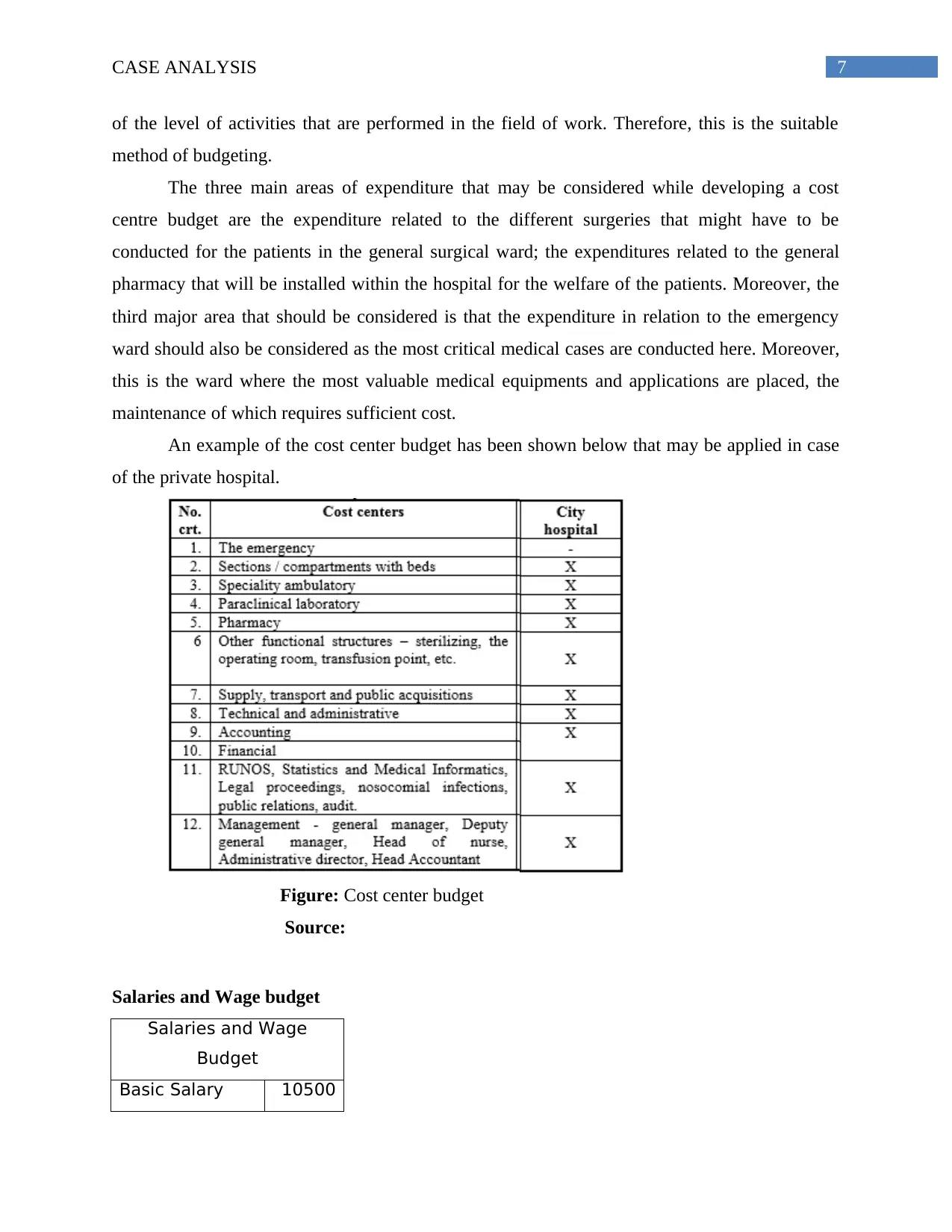
7CASE ANALYSIS
of the level of activities that are performed in the field of work. Therefore, this is the suitable
method of budgeting.
The three main areas of expenditure that may be considered while developing a cost
centre budget are the expenditure related to the different surgeries that might have to be
conducted for the patients in the general surgical ward; the expenditures related to the general
pharmacy that will be installed within the hospital for the welfare of the patients. Moreover, the
third major area that should be considered is that the expenditure in relation to the emergency
ward should also be considered as the most critical medical cases are conducted here. Moreover,
this is the ward where the most valuable medical equipments and applications are placed, the
maintenance of which requires sufficient cost.
An example of the cost center budget has been shown below that may be applied in case
of the private hospital.
Figure: Cost center budget
Source:
Salaries and Wage budget
Salaries and Wage
Budget
Basic Salary 10500
of the level of activities that are performed in the field of work. Therefore, this is the suitable
method of budgeting.
The three main areas of expenditure that may be considered while developing a cost
centre budget are the expenditure related to the different surgeries that might have to be
conducted for the patients in the general surgical ward; the expenditures related to the general
pharmacy that will be installed within the hospital for the welfare of the patients. Moreover, the
third major area that should be considered is that the expenditure in relation to the emergency
ward should also be considered as the most critical medical cases are conducted here. Moreover,
this is the ward where the most valuable medical equipments and applications are placed, the
maintenance of which requires sufficient cost.
An example of the cost center budget has been shown below that may be applied in case
of the private hospital.
Figure: Cost center budget
Source:
Salaries and Wage budget
Salaries and Wage
Budget
Basic Salary 10500
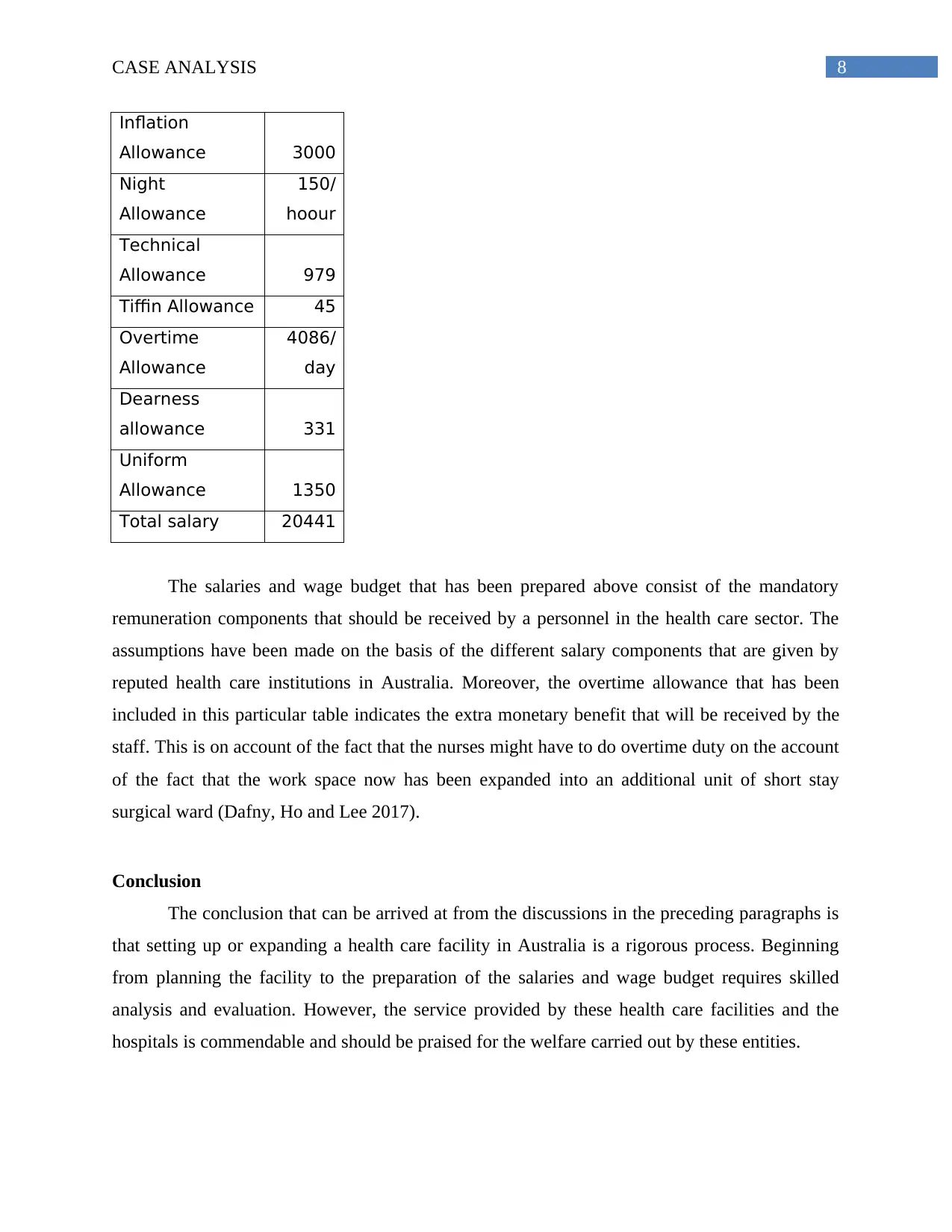
8CASE ANALYSIS
Inflation
Allowance 3000
Night
Allowance
150/
hoour
Technical
Allowance 979
Tiffin Allowance 45
Overtime
Allowance
4086/
day
Dearness
allowance 331
Uniform
Allowance 1350
Total salary 20441
The salaries and wage budget that has been prepared above consist of the mandatory
remuneration components that should be received by a personnel in the health care sector. The
assumptions have been made on the basis of the different salary components that are given by
reputed health care institutions in Australia. Moreover, the overtime allowance that has been
included in this particular table indicates the extra monetary benefit that will be received by the
staff. This is on account of the fact that the nurses might have to do overtime duty on the account
of the fact that the work space now has been expanded into an additional unit of short stay
surgical ward (Dafny, Ho and Lee 2017).
Conclusion
The conclusion that can be arrived at from the discussions in the preceding paragraphs is
that setting up or expanding a health care facility in Australia is a rigorous process. Beginning
from planning the facility to the preparation of the salaries and wage budget requires skilled
analysis and evaluation. However, the service provided by these health care facilities and the
hospitals is commendable and should be praised for the welfare carried out by these entities.
Inflation
Allowance 3000
Night
Allowance
150/
hoour
Technical
Allowance 979
Tiffin Allowance 45
Overtime
Allowance
4086/
day
Dearness
allowance 331
Uniform
Allowance 1350
Total salary 20441
The salaries and wage budget that has been prepared above consist of the mandatory
remuneration components that should be received by a personnel in the health care sector. The
assumptions have been made on the basis of the different salary components that are given by
reputed health care institutions in Australia. Moreover, the overtime allowance that has been
included in this particular table indicates the extra monetary benefit that will be received by the
staff. This is on account of the fact that the nurses might have to do overtime duty on the account
of the fact that the work space now has been expanded into an additional unit of short stay
surgical ward (Dafny, Ho and Lee 2017).
Conclusion
The conclusion that can be arrived at from the discussions in the preceding paragraphs is
that setting up or expanding a health care facility in Australia is a rigorous process. Beginning
from planning the facility to the preparation of the salaries and wage budget requires skilled
analysis and evaluation. However, the service provided by these health care facilities and the
hospitals is commendable and should be praised for the welfare carried out by these entities.
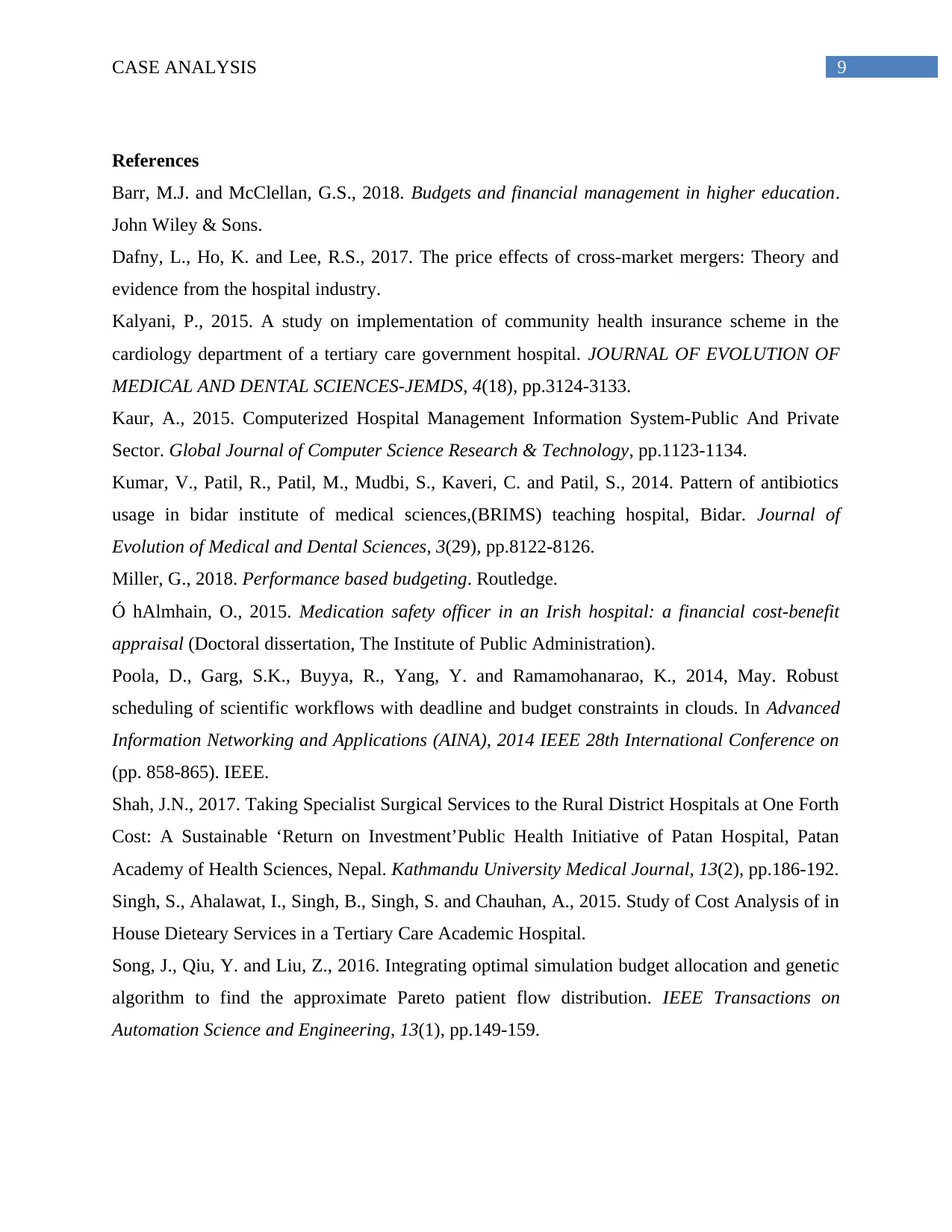
9CASE ANALYSIS
References
Barr, M.J. and McClellan, G.S., 2018. Budgets and financial management in higher education.
John Wiley & Sons.
Dafny, L., Ho, K. and Lee, R.S., 2017. The price effects of cross-market mergers: Theory and
evidence from the hospital industry.
Kalyani, P., 2015. A study on implementation of community health insurance scheme in the
cardiology department of a tertiary care government hospital. JOURNAL OF EVOLUTION OF
MEDICAL AND DENTAL SCIENCES-JEMDS, 4(18), pp.3124-3133.
Kaur, A., 2015. Computerized Hospital Management Information System-Public And Private
Sector. Global Journal of Computer Science Research & Technology, pp.1123-1134.
Kumar, V., Patil, R., Patil, M., Mudbi, S., Kaveri, C. and Patil, S., 2014. Pattern of antibiotics
usage in bidar institute of medical sciences,(BRIMS) teaching hospital, Bidar. Journal of
Evolution of Medical and Dental Sciences, 3(29), pp.8122-8126.
Miller, G., 2018. Performance based budgeting. Routledge.
Ó hAlmhain, O., 2015. Medication safety officer in an Irish hospital: a financial cost-benefit
appraisal (Doctoral dissertation, The Institute of Public Administration).
Poola, D., Garg, S.K., Buyya, R., Yang, Y. and Ramamohanarao, K., 2014, May. Robust
scheduling of scientific workflows with deadline and budget constraints in clouds. In Advanced
Information Networking and Applications (AINA), 2014 IEEE 28th International Conference on
(pp. 858-865). IEEE.
Shah, J.N., 2017. Taking Specialist Surgical Services to the Rural District Hospitals at One Forth
Cost: A Sustainable ‘Return on Investment’Public Health Initiative of Patan Hospital, Patan
Academy of Health Sciences, Nepal. Kathmandu University Medical Journal, 13(2), pp.186-192.
Singh, S., Ahalawat, I., Singh, B., Singh, S. and Chauhan, A., 2015. Study of Cost Analysis of in
House Dieteary Services in a Tertiary Care Academic Hospital.
Song, J., Qiu, Y. and Liu, Z., 2016. Integrating optimal simulation budget allocation and genetic
algorithm to find the approximate Pareto patient flow distribution. IEEE Transactions on
Automation Science and Engineering, 13(1), pp.149-159.
References
Barr, M.J. and McClellan, G.S., 2018. Budgets and financial management in higher education.
John Wiley & Sons.
Dafny, L., Ho, K. and Lee, R.S., 2017. The price effects of cross-market mergers: Theory and
evidence from the hospital industry.
Kalyani, P., 2015. A study on implementation of community health insurance scheme in the
cardiology department of a tertiary care government hospital. JOURNAL OF EVOLUTION OF
MEDICAL AND DENTAL SCIENCES-JEMDS, 4(18), pp.3124-3133.
Kaur, A., 2015. Computerized Hospital Management Information System-Public And Private
Sector. Global Journal of Computer Science Research & Technology, pp.1123-1134.
Kumar, V., Patil, R., Patil, M., Mudbi, S., Kaveri, C. and Patil, S., 2014. Pattern of antibiotics
usage in bidar institute of medical sciences,(BRIMS) teaching hospital, Bidar. Journal of
Evolution of Medical and Dental Sciences, 3(29), pp.8122-8126.
Miller, G., 2018. Performance based budgeting. Routledge.
Ó hAlmhain, O., 2015. Medication safety officer in an Irish hospital: a financial cost-benefit
appraisal (Doctoral dissertation, The Institute of Public Administration).
Poola, D., Garg, S.K., Buyya, R., Yang, Y. and Ramamohanarao, K., 2014, May. Robust
scheduling of scientific workflows with deadline and budget constraints in clouds. In Advanced
Information Networking and Applications (AINA), 2014 IEEE 28th International Conference on
(pp. 858-865). IEEE.
Shah, J.N., 2017. Taking Specialist Surgical Services to the Rural District Hospitals at One Forth
Cost: A Sustainable ‘Return on Investment’Public Health Initiative of Patan Hospital, Patan
Academy of Health Sciences, Nepal. Kathmandu University Medical Journal, 13(2), pp.186-192.
Singh, S., Ahalawat, I., Singh, B., Singh, S. and Chauhan, A., 2015. Study of Cost Analysis of in
House Dieteary Services in a Tertiary Care Academic Hospital.
Song, J., Qiu, Y. and Liu, Z., 2016. Integrating optimal simulation budget allocation and genetic
algorithm to find the approximate Pareto patient flow distribution. IEEE Transactions on
Automation Science and Engineering, 13(1), pp.149-159.
Secure Best Marks with AI Grader
Need help grading? Try our AI Grader for instant feedback on your assignments.
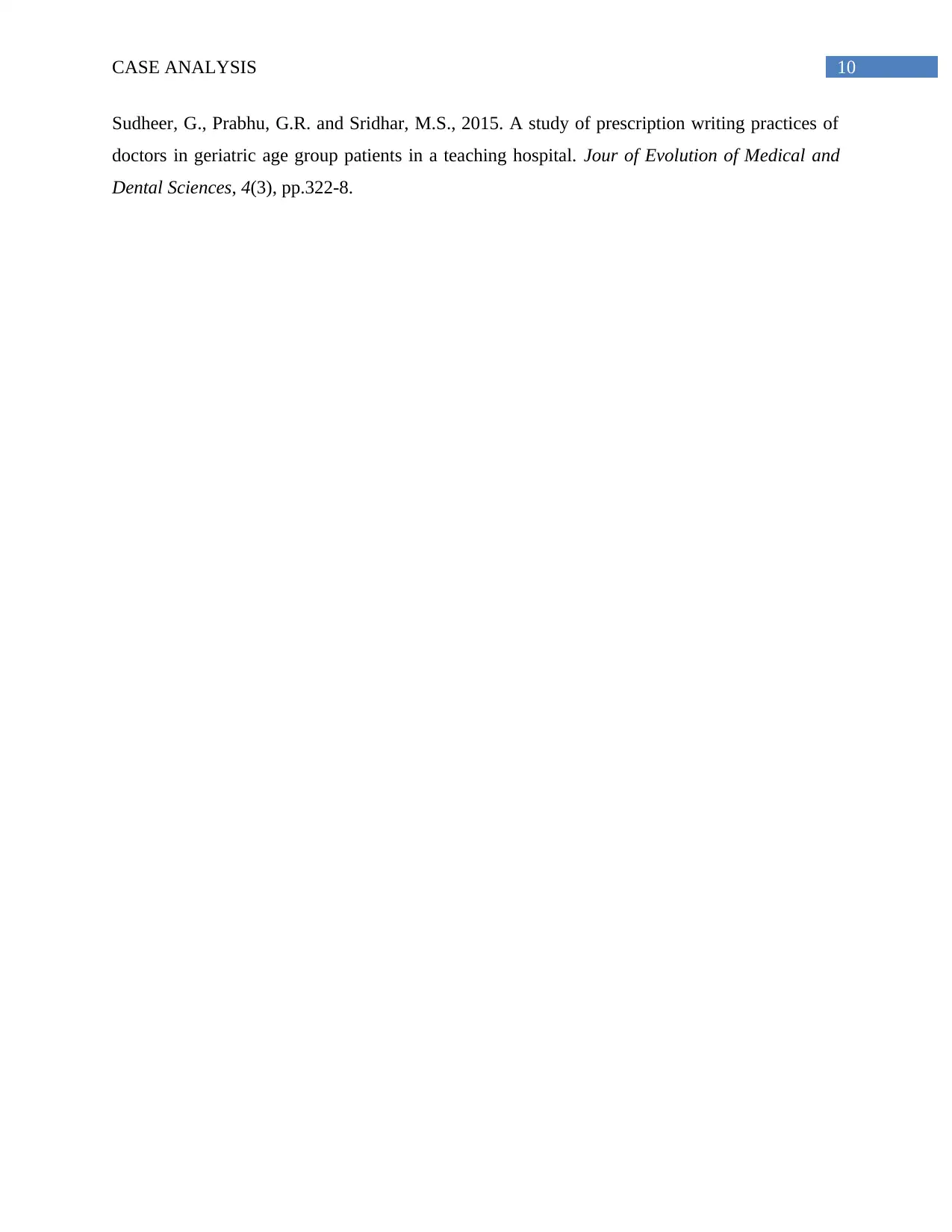
10CASE ANALYSIS
Sudheer, G., Prabhu, G.R. and Sridhar, M.S., 2015. A study of prescription writing practices of
doctors in geriatric age group patients in a teaching hospital. Jour of Evolution of Medical and
Dental Sciences, 4(3), pp.322-8.
Sudheer, G., Prabhu, G.R. and Sridhar, M.S., 2015. A study of prescription writing practices of
doctors in geriatric age group patients in a teaching hospital. Jour of Evolution of Medical and
Dental Sciences, 4(3), pp.322-8.
1 out of 11
Related Documents
Your All-in-One AI-Powered Toolkit for Academic Success.
+13062052269
info@desklib.com
Available 24*7 on WhatsApp / Email
![[object Object]](/_next/static/media/star-bottom.7253800d.svg)
Unlock your academic potential
© 2024 | Zucol Services PVT LTD | All rights reserved.




